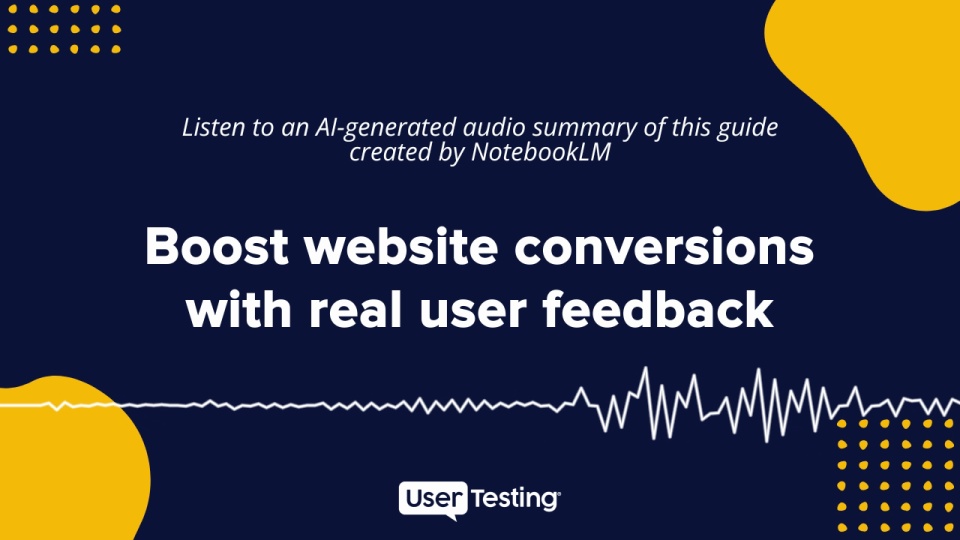
In this guide
Boost website conversions with real user feedback
Boost website conversions with real user feedback
Stop losing revenue to website friction: a data-driven approach to increasing conversion rates

Digital teams often find themselves tweaking layouts, rewriting copy, and running countless A/B tests—only to see minimal improvement in conversion rates. Why? Because traditional analytics tell you what users are doing, but not why they’re doing it.
Every digital experience has a mission—to inform, engage, and ultimately drive action. But getting visitors to convert isn't always straightforward. Understanding your customers is the key to unlocking higher conversions. It’s not just about tracking click-through rates and bounce rates; it’s about uncovering why users hesitate, drop off, or fail to engage.
This guide is designed to help you break through these barriers by leveraging human insights. Without direct customer feedback, teams are left guessing at the needs, frustrations, and motivations behind the data—and those guesses are often wrong. But with quick access to real customer insights, you can make meaningful website optimizations, validate improvements before going live, and drive better results with confidence.
Tight for time? Listen to our AI-generated audio summary of this guide created with NotebookLM.

The biggest barriers to conversion success
1. High bounce rates: the silent killer of engagement
Imagine a potential customer lands on your site, scans the homepage, and within seconds, clicks away. This moment—when a visitor decides whether to stay or leave—is one of the most critical points in the conversion funnel. A high bounce rate signals that something isn’t resonating: maybe the page load time is sluggish, the messaging is unclear, or the design feels overwhelming.
The first step to reducing bounce rates is identifying what’s causing visitors to abandon ship. Is the content mismatched with expectations? Are calls to action hidden or confusing? By diving into real user feedback, web teams can pinpoint specific moments of friction and optimize pages for greater engagement.
2. Complex navigation: when visitors can’t find what they need
A great website experience feels effortless. But when navigation paths are unclear, users get frustrated and leave. It’s like walking into a store with no signage—you’re left wandering, unsure where to go.
Common navigation pitfalls include overloaded menus, unclear categories, and buried calls to action. Streamlining site navigation isn’t just about making things simpler; it’s about making things intuitive. Web teams need to align their information architecture with how users actually think and behave, using direct feedback to validate changes before launching them site-wide.
3. Ineffective calls to action: the missed opportunity
A strong call to action (CTA) is more than just a button—it’s an invitation to take the next step. Yet many websites struggle with CTAs that are too vague (“Learn More”), buried in clutter, or not compelling enough.
CTAs should be crystal clear, action-driven, and strategically placed. Testing different CTA placements and messaging variations with real users helps ensure visitors know exactly what to do next—and feel motivated to do it.
4. Limited user insights: the guesswork dilemma
Web analytics can tell you where users drop off but can’t tell why. Without qualitative insights, teams are left guessing—relying on assumptions instead of data-driven decisions. This lack of clarity leads to ineffective optimizations, where changes are made based on hunches rather than actual user needs. The result? Frustrating experiences that continue to underperform.
Combining behavioral data with direct customer feedback is the key to solving this guesswork problem. By capturing qualitative insights—such as user frustrations, motivations, and moments of hesitation—teams can move beyond assumptions and make informed optimizations. Understanding why users struggle allows web teams to prioritize the right fixes, refine messaging, and create seamless experiences that convert.
The role of customer feedback in overcoming barriers
Why guess when you can ask?
The difference between an optimized website and a frustrating one often comes down to understanding user intent. Too often, web teams rely solely on A/B testing without first diagnosing the real issue. If a visitor doesn’t click a CTA, is it because they didn’t see it, or because the offer wasn’t compelling? Testing alone doesn’t reveal this—but user feedback does.
The power of real-time insights
When teams integrate direct customer feedback into their optimization strategy, they unlock a deeper level of understanding. Whether it’s through usability tests, recorded user sessions, or real-time user interviews, these insights help identify:
- Where users struggle and why
- What elements make users hesitate
- How messaging and design choices influence decision-making
By pairing quantitative data (bounce rates, heatmaps, conversion rates) with qualitative insights (user sentiment, verbal feedback), web teams can make informed changes that lead to higher engagement and conversions.
How UserTesting helps
UserTesting provides a direct line to customer sentiment, allowing teams to observe user behavior and capture their thoughts and motivations in real time. Through qualitative feedback, teams can uncover why users hesitate, abandon journeys, or struggle with certain elements.
- Test every touchpoint across the customer journey: By focusing tests on specific steps where drop-offs occur, teams can identify key friction points in the journey.
- Validate ideas quickly: Live Conversation interviews allow teams to engage directly with users, ensuring new concepts resonate before full implementation.
- Enhance CX with real-world design feedback: Integrated prototype testing through Figma ensures that new designs align with actual user behavior before launch.
- Convey the right message: Content testing provides insights into how users perceive messaging, making it easier to refine CTAs and information hierarchy for clarity and persuasion, allowing teams to observe user behavior in real-time. Teams can uncover why users hesitate, abandon journeys, or struggle with certain elements. This enables digital teams to make confident, data-backed decisions that drive engagement and conversions.
A framework for solving conversion challenges
Step 1: Address high bounce rates
When your analytics show a high drop-off rate on a specific page, your first instinct may be to tweak the layout, rewrite the content, or run an A/B test.
But without understanding why visitors are leaving, rooted in real customer insights, you’ll be left guessing.
How to test it
- Run a usability test focused on first impressions. Guide users to the page and ask:
- What are you expecting to see here?
- What’s your first impression of this page?
- What would you click on next?
- Are you confused? If so, about what?
- Use think-aloud testing: listen to users’ real-time reactions as they navigate the page
- Combine behavioral data with qualitative insights: heatmaps can show where users drop off, but customer feedback tells you why.
Without this kind of testing, your next step will be pure guesswork: A/B testing a hypothesis, waiting for results, and likely having to test again because your initial assumption was wrong. Real user feedback eliminates that inefficiency.
Step 2: solve complex navigation issues
A confusing navigation structure forces users to hunt for what they need. If they can’t find it quickly, they leave.
How to test it
- Conduct a tree test: evaluate whether users can easily find key content in your site structure
- Run a card sorting study: understand how users categorize information—this helps ensure your menu labels and structure align with how visitors think
- Test a specific task: watch users perform a specific task, like: “Find the pricing page” or “Locate the support center" to see where they encounter friction
- Observe hesitation: if users pause, backtrack, or rely on the search bar, your navigation needs refining
- Iterate and validate: make data-driven adjustments and test again before launching changes sitewide
Skipping this step means you’ll waste time restructuring your navigation based on assumptions rather than user behavior.
Step 3: improve ineffective calls to action (CTAs)
A CTA should guide users to take the next step, but it won't drive conversions if it’s vague, buried, or unconvincing.
How to test it
- Test multiple CTA versions with real users: Inform A/B testing by asking users:
- What does this CTA mean to you?
- Would you click this? Why or why not?
- What do you expect to happen if you click it?
- Use preference testing to compare CTA variations and get direct feedback on clarity and persuasiveness.
- Check visibility with heatmaps to see if users notice the CTA, and session recordings can reveal whether they hesitate before clicking.
- Validate your CTA messaging by ensuring it aligns with user intent—if users don’t understand or trust it, they won’t engage.
Without this insight, you’ll waste time tweaking CTA colors or placements when the issue may be unclear wording or misalignment with user expectations.
Step 4: eliminate guesswork with user insights
Traditional analytics show what is happening, but they don’t tell you why. If you don’t have user insights, every optimization is a shot in the dark.
How to test it
- Run usability tests on key friction points: Identify where drop-offs occur using analytics, then observe real users interacting with that part of the site.
- Use session replays and think-aloud testing to capture user reactions as they navigate.
- Ask the right questions:
- What’s confusing or frustrating about this experience?
- What would make this process easier for you?
- What made you hesitate?
- Test early and often: Gathering insights before making changes prevents wasted effort and costly redesigns that don’t solve the real problem.
Skipping these steps means relying on hunches, leading to inefficient testing cycles and missed opportunities for real improvements.
How UserTesting helps
By leveraging self-guided usability tests and live conversations, teams can pinpoint friction points and validate improvements before implementation.
- Unlock insights faster: Get customer feedback within hours—not weeks, getting insights without watching hours of video. AI-powered analysis tools, such as friction detection and sentiment analysis, streamline insight discovery so teams can quickly identify problem areas and prioritize impactful optimizations. By capturing real user feedback on why visitors leave, what confuses them, and how they interact with site elements, teams can make data-driven improvements with confidence—without wasting time on guesswork.
- Quickly connect with the right audience: UserTesting’s Participant Network enables teams to gather insights from their ideal customer segments, including those who abandoned key interactions.
- Pinpoint CX gaps with QXscore™: Measure overall experience satisfaction with a 100-point score to identify gaps and areas for improvement. QXscore helps teams benchmark against competitors and build a data-backed case for optimizations—making it easier to persuade stakeholders and drive meaningful changes.
- Capture first-person perspectives: Help teams understand emotional reactions and behavioral patterns with:
- Live Conversations: Recruit and schedule live interviews within a day, enabling real-time discussions with your target audience. Ask follow-up questions, explore pain points in depth, and uncover insights that drive meaningful optimizations.
- Self-guided tests: Capture both screen interactions and facial expressions within hours, providing a deeper understanding of user reactions. AI-powered sentiment analysis helps you quickly identify key themes, making it easier to turn raw feedback into actionable insights.
Turn insights into competitive advantages: Competitive testing helps teams analyze how their experiences compare to direct competitors, uncovering opportunities for differentiation.
By shifting from guesswork to customer-driven optimization, web teams can create experiences that don’t just attract visitors, but convert them. Understanding user behavior, simplifying navigation, crafting compelling CTAs, and leveraging direct feedback are the cornerstones of a high-performing digital experience. The path to higher conversions isn’t about making random tweaks—it’s about making strategic, user-informed changes that remove friction and build trust.
Case studies in conversion success
Sage: simplifying navigation for a 22% conversion lift
Sage, a global leader in enterprise software, struggled with low conversion rates. Their product pages were overwhelming, key information was difficult to find, and complex navigation frustrated potential customers.
Solution:
Through UserTesting, Sage gathered real customer insights that revealed:
- Dense product pages: Users found them difficult to scan, so Sage simplified content for better readability.
- Complicated navigation: Users had trouble finding relevant solutions, leading Sage to introduce filters for easier exploration.
- Unclear messaging: Product benefits weren’t immediately obvious, so Sage refined copy and added interactive visuals to improve engagement.
Results:
- 22% increase in conversions after refining the navigation experience
- Significant reduction in bounce rates on high-intent pages
Zenni Optical: guest checkout optimization leading to a 7.25% conversion lift
Zenni Optical, an ecommerce eyewear retailer, noticed a high cart abandonment rate, indicating significant user dissatisfaction and engagement issues.
Solution:
To address these challenges, Zenni's teams collaborated with UserTesting to gather in-depth user feedback, revealing key areas for improvement:
- Cluttered interface: Users struggled with navigation, so the team streamlined the design for better usability.
- Slow performance: Load times and crashes frustrated users, leading to optimizations for a smoother experience.
- Hard-to-find features: Key features were difficult to access, so the layout was reorganized for better accessibility.
Results:
- 7.25% increase in conversions after enabling guest checkout
- Faster checkout times, reducing drop-off rates
- Higher customer satisfaction, as users appreciated the flexibility
Panera Bread: enhancing the catering experience for a 9% YoY conversion lift
Panera Bread’s catering website was struggling with user drop-offs during the ordering process. The company needed to refine the experience to make bulk ordering more intuitive.
Solution:
To address this, Panera's teams collaborated with UserTesting to gather customer feedback, which revealed:
- Complicated ordering: Customers found the process cumbersome, so the team streamlined steps for a smoother experience.
- Impersonal experience: The website lacked warmth, so personalization features were added to reflect the in-café feel.
- Difficult navigation: Customers struggled to find catering options, so the menu structure was improved for better accessibility.
Results:
- 9% year-over-year increase in conversions for catering orders.
- Higher engagement from business customers due to streamlined ordering.
- Enhanced mobile experience, leading to increased mobile transactions.
Watch below to learn how Panera continuously improves its website conversion rates through user feedback.

Transform barriers into breakthroughs
Throughout this guide, we’ve uncovered the common barriers preventing web teams from achieving higher conversions: high bounce rates, complex navigation, ineffective CTAs, and lack of real user insights.
Trying to solve these issues through guesswork is slow and inefficient and often can waste time and money due to rework. The key to real improvement is leveraging real-time customer feedback to make informed, data-driven decisions that drive meaningful results.
By integrating continuous user feedback with UserTesting, web teams optimize digital experiences and move beyond barriers to create seamless, high-converting customer journeys across multiple touchpoints that exceed user expectations and drive business growth.



